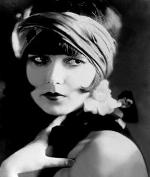The Unique Style of the 1920s Flapper Dress
|
If there is a piece of clothing that has been iconic over the decades, it is the 1920's flapper dress. Few eras have had as long lasting impact on fashion as the 1920's. The fashions of the 1920s forever changed how women were seen (and dressed up!). |
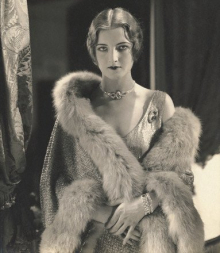 Coco Chanel, a fashion designer and model Coco Chanel, a fashion designer and model |
Page Navigation: Click the Links below to jump to specific flapper dress information on this page!
A little Fashion history...
Fashion has always embraced the societal occurrences around the world, and the period after World War I was especially crucial in the case of the women’s wardrobe, which came right alongside a burgeoning support for women’s rights.
The origin of the term "Flapper" is open to debate. Some folks say it was used to describe a young woman (bird) just learning to fly, others used the term to describe a young prostitute...
They started wearing makeup, chopped their hair off, and attended parties until the wee hours of the morning, thus were called "Flappers".
In the early 1920’s it was used to classify women who shed the typical female appearance of previous decades - meaning - they threw away the super tight corset AND started to smoke, drink, dance, drive—and vote!
Flappers were a key part as well as the Roaring Twenties. Featuring a jazz culture that was burgeoned by the presence of the "liberated" woman.
A style revolution was born!
|
From the moment that the conservative style of the past decade was left behind, the hem of the skirts started to rise. At first, it only rose a few inches, but between 1925 and 1927 a flapper's skirt fell just below the knee. So for the first time in modern society, women wore free spirited dresses that allowed them to dance without shame of their bodies. At the time, the Charleston (a dance that involved ragtime jazz in a quick 4/4 time whilst swinging the legs and arms) was very popular, and became the flapper's dancing calling card. |
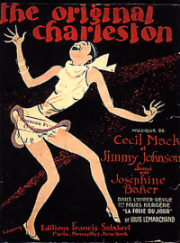 Josephine Baker had a huge influence on the flapper community and was a purveyor of the Charleston Josephine Baker had a huge influence on the flapper community and was a purveyor of the Charleston |
Average 1920's flapper dresses typically combine wide or thin straps that left the majority of the arm bare.They also have a straight and often loose fit due to the desirable androgynous style and also sport a dropped waist, which also helps draw the mind away from what was considered a womanly shape in the decades prior.
Usually, the hemlines of 1920's evening dresses were the same knee-length lines as day dresses. On the other hand, the hemlines rose to just below the knee, and later, inches above, exposing women’s legs when they walked or danced the Charleston.
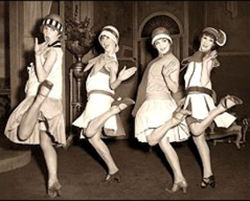
Overall, most of the pieces were made of very delicate, thin, and airy fabrics. Since the most fashionable silhouette for a woman's skirt was straight and knee-length, most dresses featured straight hemlines that neatly circled the upper calves.
|
However, more flowing lines came into fashion later in the decade. The handkerchief hemline was created by circling the waist with an over-skirt made of thin, transparent panels of fabric, which gave glimpses of the shorter straight hem of the tubular dress below. One corner of each fabric panel pointed toward the floor, giving the hemline an uneven look. As a formal costume, the 1920's flapper dress style is never much longer than knee length – which was already considered super short in those days! |
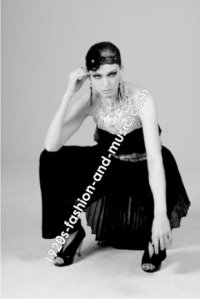 A modern look in the 1920's flapper dress style A modern look in the 1920's flapper dress style |
The evening dresses in the 1920's were always stunning. Some of them were heavily beaded and decorated with clusters of fringes, beads, rhinestones, or crystal that accented the layers as the rows of the following embroidering give them a remarkable effect.
The fabrics as well were expensive and featured bold designs of geometric themes belonging to the Art Deco style.
Only the wealthiest flappers could afford the metal sequins and threads for their formal dress, the less affluent ended up replacing it with affordable and less flashy options.
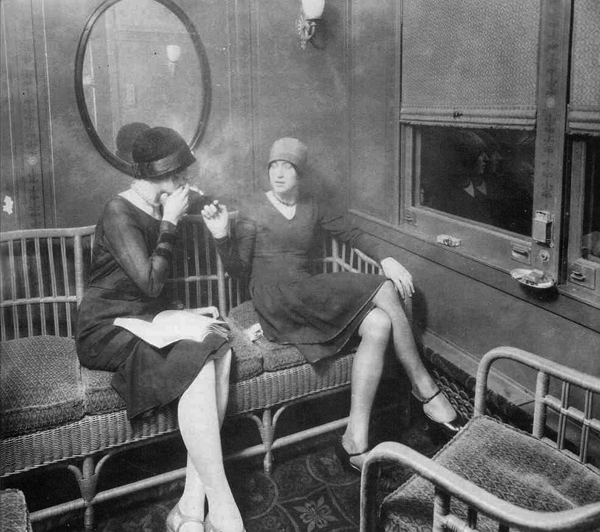 Flappers smoking in a train car
Flappers smoking in a train carThe Simple Beauty of 1920's Flapper Fashion
If you're like most people, flappers, gangsters, and jazz are the first things that come to mind when think about the 1920's.
The Roaring Twenties is remembered for its unique vibrancy, and an unmistakable love of life. Life imitates art. . . yet in the 20's fashion tends to imitate life--nowhere is this more apparent than in flapper fashions.
The nightlife of the Jazz Age, with the wild dances like the Charleston, and the vibrancy of jazz music, fashion morphed into a stylish blend of design, beauty, and practicality.
The wonderful beaded flapper dresses allowed women to move freely while dancing and exposed her body in an alluring (and to some people immoral) way.
Flapper dresses were integral to the spectacle of the dance: arms, skirts, legs, and fabric all moving at once in a whir of activity and vitality.
As well as doing a good job of pissing off the people who thought women should dress in a specific way.
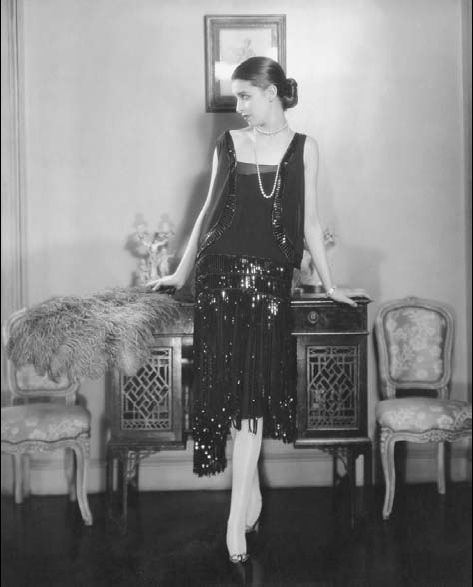 The famous "little black dress" is a 1920s flapper style dress created by Coco Chanel
The famous "little black dress" is a 1920s flapper style dress created by Coco ChanelAlthough most of the evening flapper dresses were heavily decorated, the fringe ones, weren’t really popular in the 1920's. Archives show that sequined fringe dresses were worn, but mostly by dancers as a costume. On the other hand, the fringed version that is pretty famous as a figurine in the movie "The Great Gatsby (2013)," was actually a revival predominant between the 1950's and 1960's.
Whether for a costume of a Halloween party or a special occasion, an authentic flapper outfit is composed of a dress made of a light material like chiffon, silk, satin or crepe.
In contrast, the sequined/fringed ones are the best option to stand out due to their glittery/shimmery nature.
Accessories like a pearl necklace, cloche (bell-shaped) hat, or any headband decorated with embroidery, beads, and feathers would admonish the 1920's flapper dresses of the day.
Moreover, the flapper shoe known as the Mary Jane (single center strap) or t-straps, were foremost in allowing any foot to dance the Charleston tirelessly.
The 1920's Flappers could really move. . .
Fashion, music, and attitude blending together perfectly! The music, movies, and books of the 1920's all demonstrate that America had sex on the brain. The quintessential celebrity of the Jazz Age, Louise Brooks, pretty much summed up flapper attitudes when she said:
"I like to drink and f*ck." -Louise Brooks
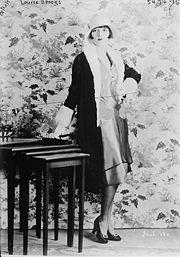 Louise Brooks: Famous flapper and lady of modern culture
Louise Brooks: Famous flapper and lady of modern cultureThe favorite songs of the day were not as brash as Brooks, but certainly suggest the same preoccupation with sex: Hot Lips, I Need Lovin', and Nursing Kisses. The New Yorker author, gadfly, and fair-weather flapper, Lois Long, had the same basic opinion as Brooks:
"Tomorrow we may die, so let's get drunk and make love."
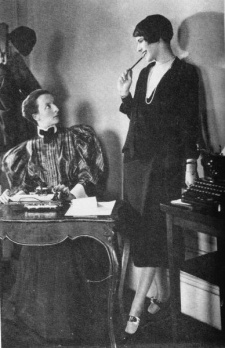
Flapper fashion owes as much to the behaviors and attitudes of the women wearing them as the style of the clothes themselves. What beautiful clothes they are: simple, sexy, and modern. They really don't look like what you imagine your grandma's outfits to look.
Flapper dresses and flapper jewelry go together like a hand and glove. . . short hemlines, slave bracelets, and bobbed hair, the flapper continues to reflect the liberated and fashion forward woman of today. The famous song during the 1920's goes. . . She's a highly energetic, undissuadable, magnetic, peripatetic, athletic kind of girl.
Flappers’ Fashion Legacy
Flappers were tired of dressing up like what a typical lady would have worn in the previous century, which was the era of large exceedingly flamboyant dresses; so they adopted the “la garconne” (boyish) style, hugely popularized by Coco Chanel, which made it a must have look. This style was purposely designed to hide womanly curves, which was forgiving to different body types.
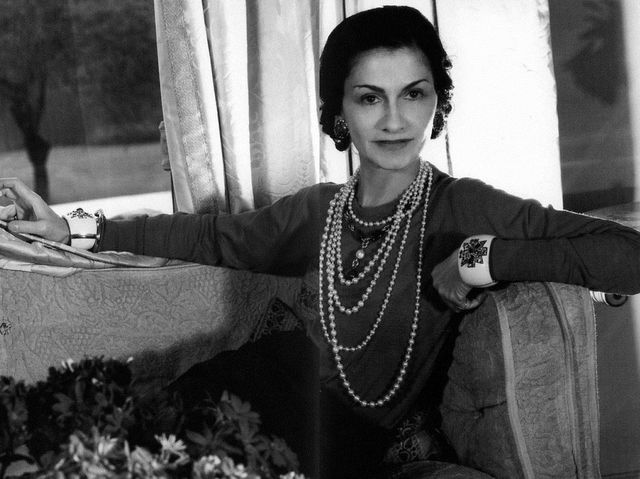 Coco Chanel looking elegant
Coco Chanel looking elegantFor the Spring 2018 Couture show, famous fashion designers such as Paco Rabanne and Elie Saab were inspired by the 1920s atmosphere. Elie presented different dresses full of sequins, feathers, or embroidery, although she didn’t preserve the single dropped waistline of the time. Therefore, the flapper not only left a legacy for the fashion world but also a legacy for the entire world which is clearly felt even today.
The 1920's flapper cut a beautiful silhouette!
Marked by a beautiful blend of grace and simplicity, flapper fashion made the most of a stripped down style and made fashion modern for a rapidly evolving society.
1920's flapper dresses used the new attitudes and standards of the modern woman to carve out it's own niche in the fashion world.
Coco Chanel, Paul Poiret, and other visionary fashion designers had pivotal roles in defining the flapper style.
Poiret made his mark by ridding modern fashion of the corset, Vionette made hers with the intricate cutting techniques, while Chanel simply redefined fashion.
Chanel's designs were never extravagant or overdone.
They took a new look at what it meant to be a woman in the modern world and built a brand new fashion around it. Her dresses were made for "flappers" because they allowed a woman to move, wouldn't fall apart when she danced, and were as appropriate for the outdoors as the indoors.
Both modern and 20's flapper fashion owe a lot to the vision of Coco Chanel.
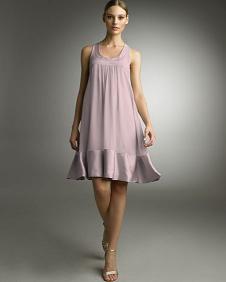
The Elegance of the Flapper Dress
"Beauty is like balancing a diamond on a blade of grass"
What's so alluring about the flapper style? From Nicole Kidman to Kate Moss, the flapper look is almost as popular today as it was in the 1920s; influencing common fashion icons every day. Done wrong, the look can be just plain bad. . . done right it's incredibly sexy and unique.
The style is naturally slimming - elongating the body and highlighting a woman’s features. With a bubbly personality, the right dress, beautiful shoes, a simple necklace, and some dangling earrings - will ensure you are the most intriguing and elegant guest at any costume together. We’re here to give the information necessary to make that happen.
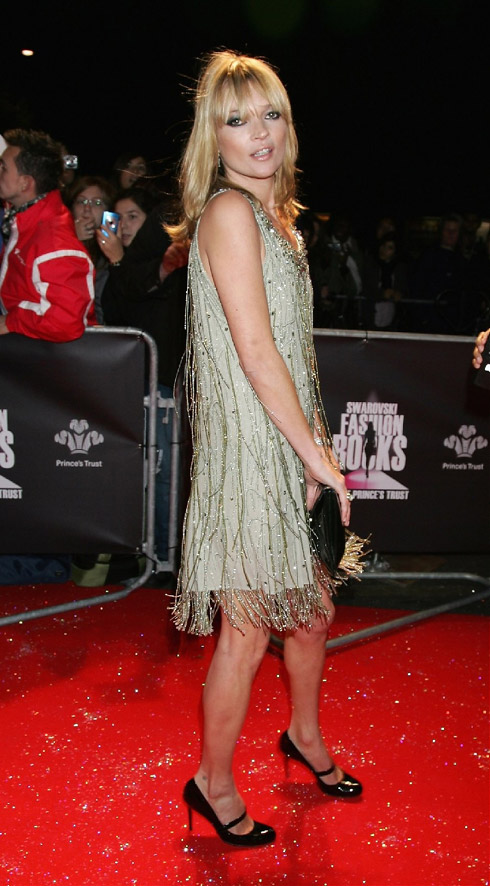 Kate Moss proving the influence of the 1920's on modern fashion
Kate Moss proving the influence of the 1920's on modern fashionCelebrate the 1920s With Your Own Flapper Dress Pattern
The greatest thing about the flapper dress pattern is it's simplicity. As legend has it, the flapper silhouette was invented by Coco Chanel while she was vacationing in Deuville, France. One chilly morning she woke up and slipped into her lover's large sweater and simply tied the waist with a handkerchief. At that moment the 1920's flapper dress was born. When Chanel went out in public people reacted to the great dress she was wearing, and by the end of the day she had sold 10 of these new frocks.
The Satisfaction of Making Your Own Clothes
As many creative people know there's a certain satisfaction that comes from making your own clothes and having people come up and ask, "where did you get that dress?"
The flapper dress pattern is the perfect dress to start with because it is so versatile and simple.
You can sew the dress following the pattern exactly, or you can stretch your wings and give it a unique twist, just for you.
Because the flapper dress can be made in so many different fabrics, you can start with cheap cotton to perfect your flapper dress first, then once you have it down, make your dress in whatever fabric you want.
Typical flapper dresses in the 1920's were made from everything from cotton burlap to the finest silks.
It's a good idea to have several different types of materials on-hand to choose from once you have mastered the pattern of your 1920's style flapper dress.
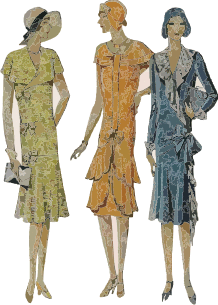 Three iterations of common popular flapper designs
Three iterations of common popular flapper designsA Dress For Any Occasion
Above is a great vintage sewing pattern, whether you're making a dress for a special event, like a vintage 1920's wedding, a Halloween costume party, or you just like to maintain a little bit of a retro dress code in your life.
Because of the simplicity of the pattern, much of the dress's personality is going to have to come from you. You'll have to choose the cloth carefully, decorate or embroider the fabric tastefully, and choose your accessories wisely to come up with an outfit that reflects your good taste and vibrant nature.
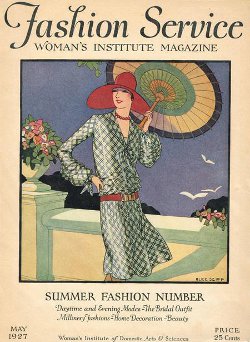 A fashion magazine with the style of the time on the front
A fashion magazine with the style of the time on the frontThe Inspiration is Easy
Just look at the flapper dress patterns of the 1920's, if you get stuck, there are thousands of 1920's fashion pictures and blogs on the internet to lend inspiration to your next sewing project.
If you're just getting started sewing and you're looking for an easy to follow guide, look no further than this one hour flapper dress pattern It will guide you from start to finish.For more experienced seamstresses, eBay is a great place to find patterns from the 1920's, there are many quality reproduction patterns available at a very decent price.
Sometimes you can pick them up for just pennies.
